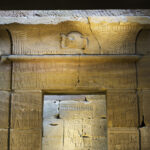 Unsplash/Getty
Unsplash/GettyWe tend to think of our modern routines and daily habits as uniquely contemporary, shaped by convenience, technology, and the fast pace of life. But if you scratch beneath the surface, you’ll find that many of the things we do without a second thought—like brushing our teeth, keeping a pet, saying cheers before a drink, or scribbling down a to-do list—have ancient origins. These aren’t new ideas, but rather old solutions that have evolved and been repackaged for modern times. The motivations behind them—practicality, community, comfort, or ritual—haven’t changed much at all. Here are some everyday habits with roots that stretch much further back than we often realise.
Brushing our teeth
We may have electric toothbrushes, whitening pastes, and mouthwash on tap now, but the basic idea of cleaning our teeth is ancient. Archaeological finds suggest the Egyptians were using frayed twigs as far back as 3000 BCE to scrub their teeth. These ‘chew sticks’ acted much like modern brushes. The Greeks and Romans followed with powders made from crushed bones, oyster shells, and charcoal, sometimes mixing in spices to freshen the breath.
In India and parts of the Middle East, neem and miswak sticks have been used for centuries and are still in use today. During the Middle Ages, people in Europe used cloths, salt rubs, and herbs to clean their mouths. While dental care was inconsistent and often cosmetic, the desire to maintain oral hygiene has clearly been around for thousands of years.
Using makeup and skincare
From highlighters to serums, today’s booming beauty industry owes a debt to civilisations that long ago understood the power of appearance. Ancient Egyptians are perhaps the most famous for this—both men and women wore kohl eyeliner not just for beauty but also to reduce glare from the sun and ward off infections. Ingredients like malachite and galena were ground into pastes for their cosmetic and medicinal qualities.
Romans used lead-based powders to whiten their faces and often used saffron as a blush. Cleopatra’s routines included milk baths, honey masks, and crushed beetles for red lipstick. In ancient China, rice water and pearl powder were used for glowing skin. The idea of skincare as both a health routine and a beauty ritual is nothing new—just more refined (and hopefully less toxic) today.
Shaking hands
This common greeting is so familiar it’s easy to forget its original purpose: reassurance. In ancient Greece, handshakes appear on stone carvings as symbols of peace and alliance. Offering an empty right hand proved you weren’t concealing a weapon. It was a gesture of trust in a world where mistrust could be deadly.
By Roman times, the handshake evolved into a greeting among equals, with soldiers and officials clasping forearms as a sign of solidarity. Over centuries, it became more ceremonial, spreading through different cultures as a mark of respect, friendship, or agreement. Today, it’s as much about etiquette as it is tradition.
Celebrating birthdays
Birthday cake, candles, and parties might feel like recent inventions, but the roots go way back. Ancient Egyptians celebrated the ‘birth’ of pharaohs when they ascended to the status of gods. In ancient Greece, moon-shaped cakes were offered to Artemis, goddess of the moon, and lit with candles to mimic her divine glow.
The Romans formalised birthday celebrations, particularly for emperors and prominent men. Ordinary citizens started to mark their birthdays too, often with small gatherings. The modern twist—with cakes, parties, and presents—was shaped over centuries, but the core idea of marking another year of life has always had social and sometimes spiritual weight.
Toasting with drinks
Whether it’s raising a glass at a wedding or saying “cheers” at the pub, toasting is more than just polite. It has roots in ancient rituals. The Greeks made libations to the gods before drinking, pouring the first drop of wine onto the ground in honour. In Roman times, toasts were formalised in feasts, often to the emperor or the gods.
In medieval Europe, clinking glasses was said to be a way to prove drinks weren’t poisoned. Sometimes wine was poured from one goblet to another to reinforce trust. The tradition of toasting has endured not because of superstition, but because it reinforces social bonds, celebration, and shared experience.
Keeping pets
Our relationships with animals go way back. Domesticated dogs have been living alongside humans for at least 15,000 years, likely longer. Ancient Egyptian tombs are filled with images and mummified remains of beloved pets, particularly cats. These animals were not just companions but protectors and symbols of good fortune.
Romans had pet dogs and birds, with some even buried with engraved memorials. In imperial China, certain breeds of dog were kept exclusively by royalty. Animals served many roles—guardians, hunting aides, spiritual protectors—but they were also companions. Our emotional connection to pets is an ancient instinct, not just a modern indulgence.
Using calendars
Keeping track of time isn’t just for planners and smartphones—it’s one of humanity’s oldest priorities. The earliest calendars were lunar, marking months by moon phases. The Babylonians used a calendar divided into seven-day weeks based on celestial bodies. The ancient Egyptians developed a solar calendar with 365 days to track the flooding of the Nile.
The Roman calendar evolved into the Julian and later the Gregorian system we use today. Mayan, Chinese, and Hindu calendars reflect complex understandings of astronomy and time. While we now use digital devices to plan our days, the underlying need to structure time has always been central to civilisation.
Wearing jewellery
The impulse to adorn ourselves is older than any written language. The oldest jewellery ever found—perforated shell beads—dates back over 100,000 years. Across ancient civilisations, jewellery was used not just for decoration, but as a symbol of power, spirituality, or tribal belonging.
Ancient Mesopotamians wore amulets for protection. Egyptians used jewellery to honour the gods and accompany the dead into the afterlife. Romans flaunted wealth with rings and brooches. Whether it’s a wedding ring or a pierced earring, our jewellery still says something about who we are and what we value.
Writing shopping lists
We might use a notes app now, but the act of jotting down what we need is as old as writing itself. The earliest known examples of writing—Sumerian cuneiform tablets from around 3,000 BCE—include lists of goods, trades, and supplies. These were essential for managing growing cities and trade networks.
These ancient records evolved into accounting systems, contracts, and inventory logs. The simple act of listing what to buy at the market is a direct descendant of these early administrative tools. It’s not just a chore—it’s part of the evolution of literacy and economy.
Practising yoga and meditation
Wellness apps and mindfulness trends may be booming now, but yoga and meditation go back thousands of years. The earliest references to yoga appear in the Rigveda, a sacred Indian text written over 3,000 years ago. It wasn’t just physical exercise—it was a spiritual path to discipline and enlightenment.
Meditation has been a cornerstone of Buddhism, Hinduism, and Taoism for millennia. Whether practiced in temples, caves, or forests, it was used to cultivate awareness, clarity, and inner peace. Modern interest in mental well-being and balance draws directly from these ancient traditions.
Bathing for health
We tend to associate baths with relaxation, but bathing as a health ritual dates back to ancient times. The Romans built elaborate bathhouses with hot, warm, and cold rooms. Public baths were places of socialising, cleanliness, and sometimes even healing, as mineral-rich waters were thought to have curative powers.
In Japan, onsen culture developed around natural hot springs. Turkish hammams and Scandinavian saunas also reflect the idea that bathing isn’t just hygienic—it’s restorative. Our modern spa culture and long soaks in the tub owe much to this ancient understanding of water as a pathway to well-being.
Using pillows
Cushions might seem like a creature comfort of modern life, but the earliest pillows date back to ancient Mesopotamia. These were carved from stone—not exactly soft, but designed to keep the head elevated and protect hairstyles or avoid insects.
In ancient China, porcelain and wood pillows were common, often decorated with art and symbolism. The Greeks and Romans eventually developed softer versions filled with straw or feathers. Pillows became more comfortable over time, but their role in sleep, posture, and comfort has been long established.



